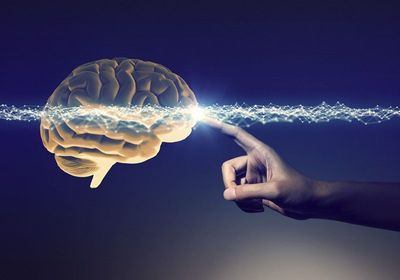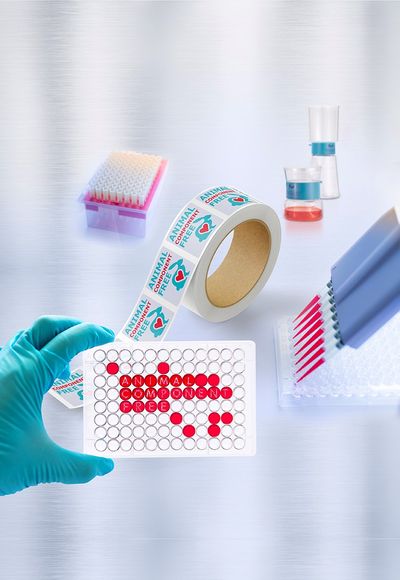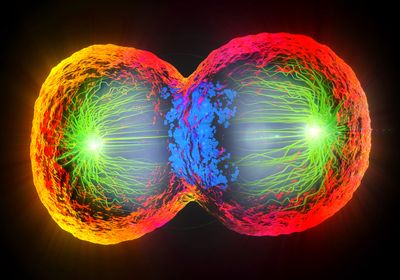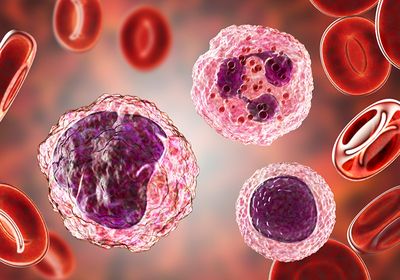ABOVE: The injured brain can produce more stem cells in response to an electrically conductive polymer transplant loaded with human stem cells. (C) ISTOCK.COM METAMORWORKS
Humans are bioelectrical beings. The collections of cells that make up tissues and organs communicate using the language of voltages and electric fields. This electrical code is produced by specialized ion channels and proteins imbedded in cell membranes. Bioelectricity also directs embryonic development. Long before the growing brain reaches maturity, stem cells are abuzz with activity, engaging in bioelectrical conversations.1 This network chatter coordinates the self-organization of tissues and gives physical shape to the human body, including the brain—a concept that was first popularized by Harold Saxton Burr in 1935.2 Although controversial at the time, modern technology eventually showed the prescience of Burr’s idea, providing a basis for exploring the intrinsic regenerative potential of the human body.3,4
Recently, Paul George, an assistant professor of neurology and neurological sciences at Stanford University, and his team applied insights from the field of developmental bioelectricity to regenerate the brain. “People respond very differently to strokes—younger patients recover a lot better than older patients. We asked whether we could recreate that younger environment,” George said. “A lot of cues help with the formation of the nervous system, including electrical, chemical, and physical cues.” Optimizing these conditions can help transplanted stem cells survive, integrate with local brain cells, and stimulate the body’s own repair mechanisms.
George and his team examined whether neural stem cell transplantation combined with electrical stimulation could restore brain function in an animal stroke model and reported their findings in Nature Communications.5 They created an electrically conductive polymer loaded with human neural stem cells, implanted this novel bioelectrical device into the stroke-injured brains of rats, and tracked the animals’ recovery over time.
George’s team found that electrically stimulating the transplanted stem cells and surrounding tissue improved brain healing and functional recovery faster and more robustly than only transplanting stem cells or applying electrical current. They also discovered that electrically stimulating transplanted stem cells upregulated a gene responsible for producing stanniocalcin 2 (STC2)—a neuroprotective protein that controls cell proliferation.5-8 Higher levels of STC2 increased stem cell production by the brain and mediated stroke recovery. “It’s well accepted now that the brain continues to make its own stem cells throughout life. In animal models, these cells go to the areas of injury and if there’s more of these cells, the animals recover better from stroke. That may be a mechanism for this improved recovery,” George explained.
“The major advance here is the mechanism of action through the STC2 pathway,” said Cesario Borlongan, a distinguished professor of neurosurgery and brain repair at the University of San Francisco who was not involved in this study. The findings are compelling because blocking STC2 also blocks the brain’s production of new stem cells. Understanding how electrical stimulation reawakens stem cells is the key to unlocking the brain’s intrinsic regenerative capacity. Scientists know that electricity stimulates stem cell survival, proliferation, and migration to the site of injury, but understanding the causal link between these phenomena is considered a breakthrough. “Up until now, we didn’t know the real mechanism,” Borlongan said.
The conductive polymer provides both a physical scaffold for the stem cells and a route for electrically stimulating them, affecting how transplanted and local stem cells differentiate and the chemical factors they produce to stimulate healing. Whether this represents a reawakening of dormant developmental processes remains to be seen. Eighty years after Burr said that “electricity seems to bridge the gap between the lifeless world and living matter,”9 George’s conductive polymer system is tapping into the electrical language of neural stem cells, acting as a conduit to revive and reshape the injured brain.
References
- Levin M. Bioelectric signaling: Reprogrammable circuits underlying embryogenesis, regeneration, and cancer. Cell. 2021;184(8):1971-1989.
- Burr HS, Northrop FSC. The electrodynamic theory of life. Q Rev Biol. 1935;10(3):322-333.
- Levin M. Revisiting Burr and Northrop’s “The electro-dynamic theory of life” (1935). Biological Theory. 2020;15(2):83-90.
- Mathews J, Levin M. The body electric 2.0: recent advances in developmental bioelectricity for regenerative and synthetic bioengineering. Curr Opin Biotechnol. 2018;52:134-144.
- Oh B, et al. Electrical modulation of transplanted stem cells improves functional recovery in a rodent model of stroke. Nat Commun. 2022;13(1):1366.
- Ito D, et al. Characterization of stanniocalcin 2, a novel target of the mammalian unfolded protein response with cytoprotective properties. Mol Cell Biol. 2004;24(21):9456-9469.
- Law AY, Wong CK. Stanniocalcin-2 is a HIF-1 target gene that promotes cell proliferation in hypoxia. Exp Cell Res. 2010;316(3):466-476.
- Kim PH, et al. Stanniocalcin 2 enhances mesenchymal stem cell survival by suppressing oxidative stress. BMB Rep. 2015;48(12):702-707.
- “Measures output of current by growing corn during tests,” Reading Eagle, 30, 1942, Available at: https://news.google.com/newspapers?id=jbwhAAAAIBAJ&sjid=qpwFAAAAIBAJ&pg=3430%2C2196864, Accessed 20 October 2022.








